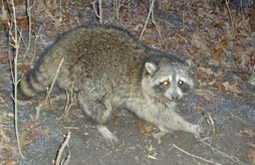A long and torturous death
Raccoons are trapped. Trappers benefit from the natural curiosity of young raccoons and set up their traps in small earth caves, in hollow trees or similar places. Usually, the traps are baited. Animals that trigger these traps are clamped up painfully. Often, the trap will snap on to a particularly painful body part such as the animal’s snout or eye area. This leads to confusion, pain and fear. The animals desperately attempt to free themselves from the trap, thus dislocating joints and injuring themselves seriously.
In order to free themselves, the animals will sometimes bite off their own limbs. If an animal is able to free itself from a trap, it will probably not survive and die of infections, starve to death or become easy prey for other animals. Animals unable to free themselves die a slow death if not found and beaten to death by the trapper or eaten by a predator. An additional problem is that often other animals get caught in the traps - amongst others, protected wild animals or pets such as cats and dogs.
Trapping for fur must be rejected for animal protection reasons. This has nothing to do with wild life management and maintaining sound animal populations, although this is claimed time and again by the fur industry.

